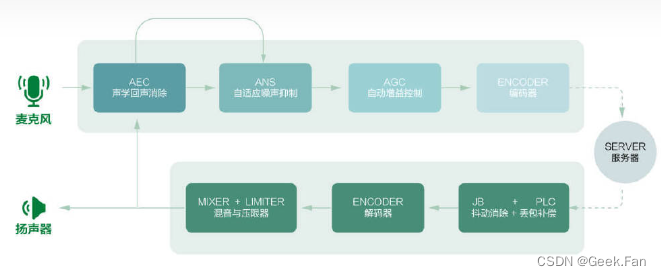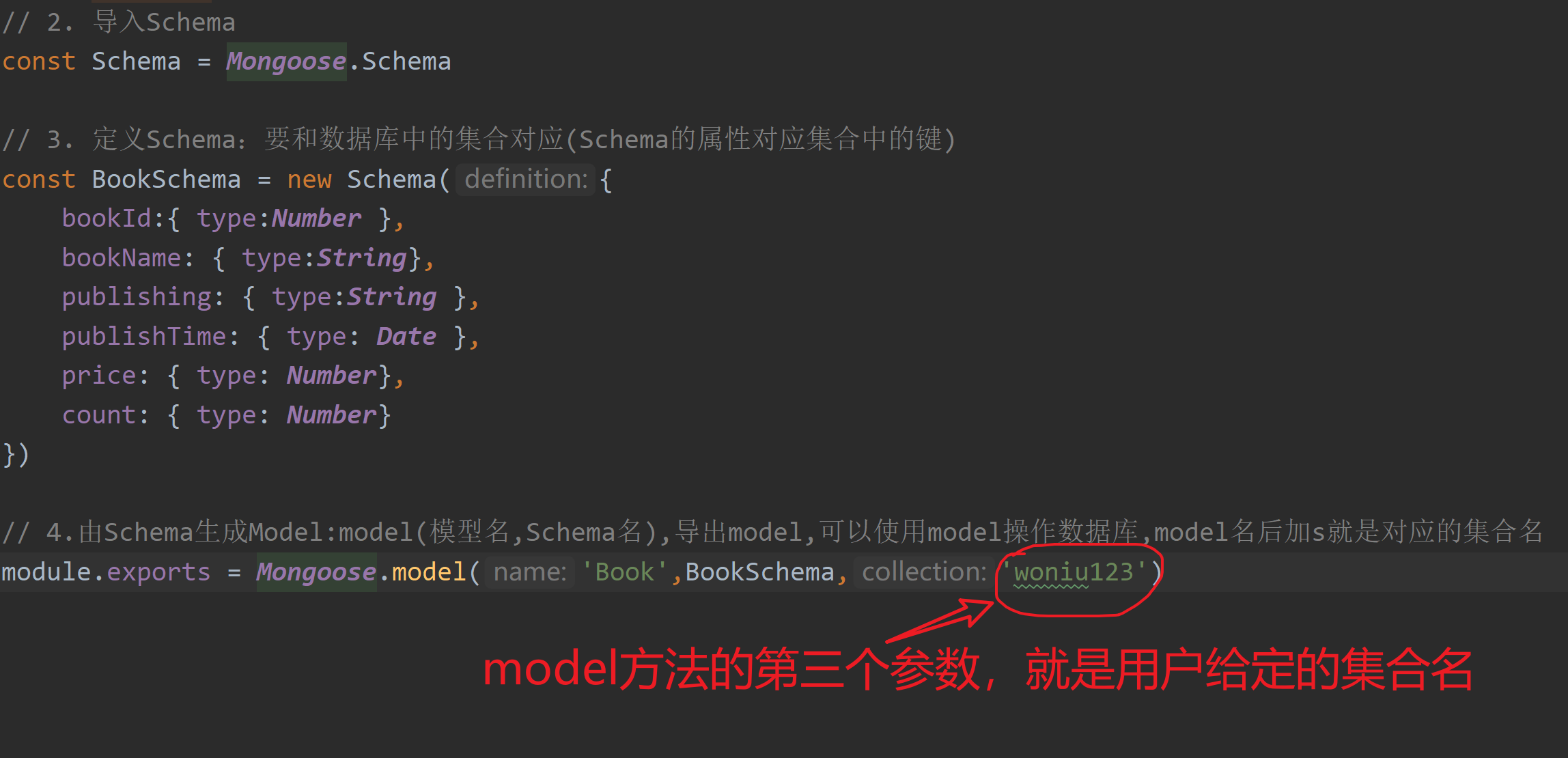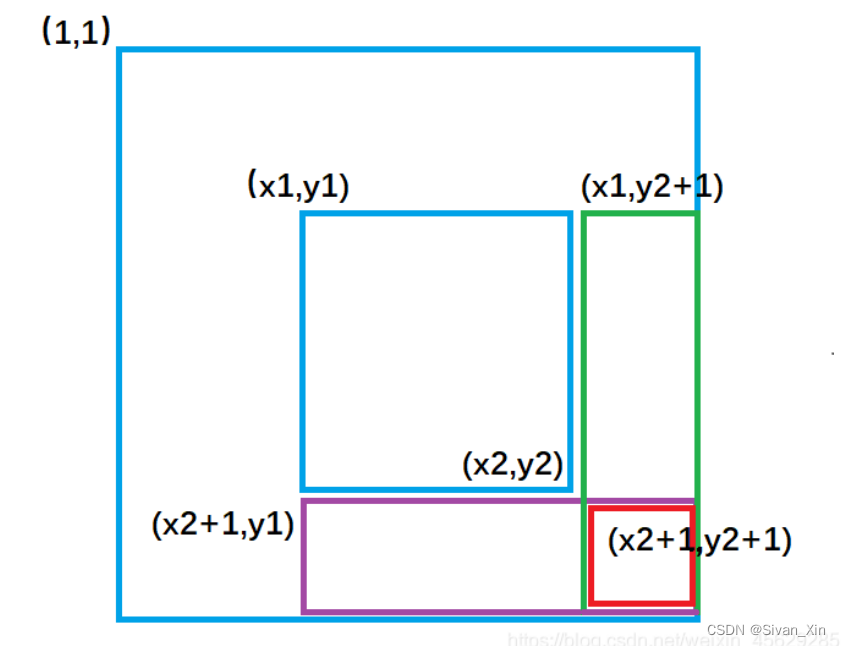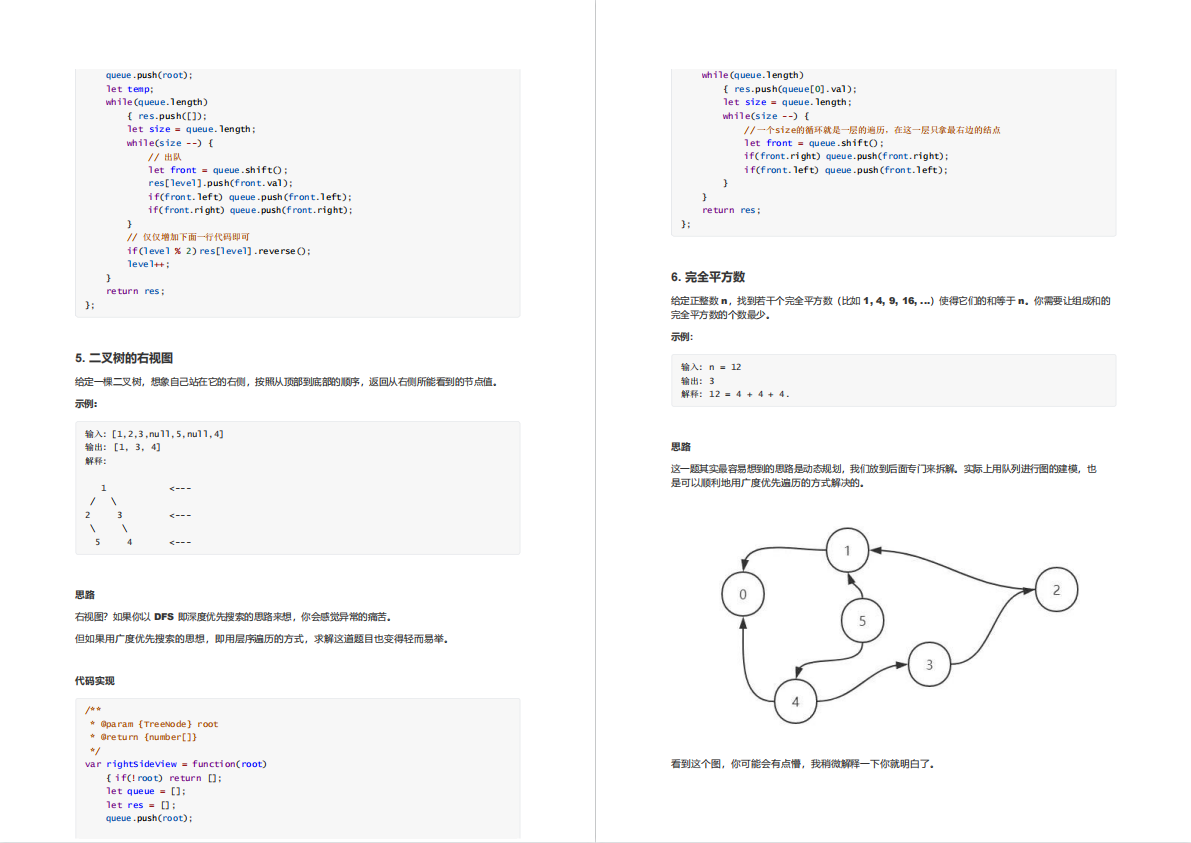上一篇我们分析了hmap,hamp可以说是Open vSwitch中基石结构,很多Open vSwitch中数据结构都依赖hmap。本篇我们来分析一下ofpbuf,这个结构,我们从名字上就可得知,此数据结构用于存储数据的,比如收发OpenFlow报文。 我们首先来看一下,它数据结构定义。(有些内容我是直接写在代码注释中的)
/* Buffer for holding arbitrary data. An ofpbuf is automatically reallocated
* as necessary if it grows too large for the available memory.
*
* 'frame' and offset conventions:
*
* Network frames (aka "packets"): 'frame' MUST be set to the start of the
* packet, layer offsets MAY be set as appropriate for the packet.
* Additionally, we assume in many places that the 'frame' and 'data' are
* the same for packets.
*
* OpenFlow messages: 'frame' points to the start of the OpenFlow
* header, while 'l3_ofs' is the length of the OpenFlow header.
* When parsing, the 'data' will move past these, as data is being
* pulled from the OpenFlow message.
*
* Actions: When encoding OVS action lists, the 'frame' is used
* as a pointer to the beginning of the current action (see ofpact_put()).
*
* rconn: Reuses 'frame' as a private pointer while queuing.
*/struct ofpbuf {//这个有一个预编译,为了简单起见,我们认为DPDK_NETDEV宏无效(关于DPDK网上有很多资料)。
#ifdef DPDK_NETDEV
struct rte_mbuf mbuf; /* DPDK mbuf */
#else
void *base_; /* First byte of allocated space. 指向内存申请的起始位置。释放内存时候此变量传给free */
void *data_; /* First byte actually in use. 指向当前可用内存起始位置。最开始base_和data_ 是一样的 */
uint32_t size_; /* Number of bytes in use. 表示内存已经使用的字节数 当size_ = allocated时候表示内存用完。 */
#endif
uint32_t allocated; /* Number of bytes allocated. 表示从系统中申请的内存块大小*/
void *frame; /* Packet frame start, or NULL. 这个字段可参考上面注释*/
uint16_t l2_5_ofs; /* MPLS label stack offset from 'frame', or
* UINT16_MAX 2.5层 偏移量 */
uint16_t l3_ofs; /* Network-level header offset from 'frame',
or UINT16_MAX. 3层网络层 偏移量*/
uint16_t l4_ofs; /* Transport-level header offset from 'frame',
or UINT16_MAX. 4层传输层 偏移量*/
enum ofpbuf_source source; /* Source of memory allocated as 'base'. 表示该内存来自堆、栈,主要用于内存释放。取值为ofpbuf_source枚举*/
struct list list_node; /* Private list element for use by owner. 链表节点。 用于将多个ofpbuf关联在一起 */
};
//枚举类型
enum OVS_PACKED_ENUM ofpbuf_source {
OFPBUF_MALLOC, /* Obtained via malloc(). */
OFPBUF_STACK, /* Un-movable stack space or static buffer. */
OFPBUF_STUB, /* Starts on stack, may expand into heap. */
OFPBUF_DPDK, /* buffer data is from DPDK allocated memory.
ref to build_ofpbuf() in netdev-dpdk. */
};下面是可能的存储结构图:
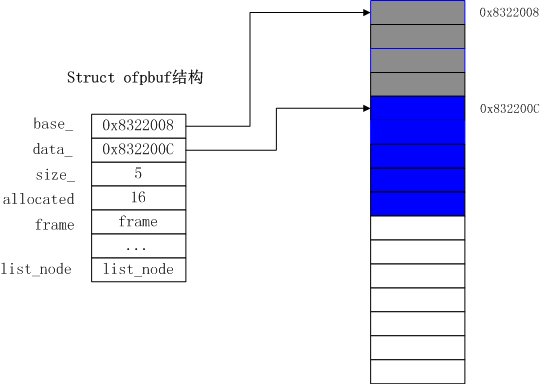
上图表示,分配16个字节空间,灰色部分为预留空间(4字节),蓝色为占用空间(5个字节),白色为剩余可用空间(7个字节)。
数据结构相对简单,我们看一下主要函数。由代码中的注释可知,数据结构ofpbuf支持内存空间自动扩充,可以理解为简单内存池。为了深入就理解ofpbuf,我们选择一个从堆中申请内存的例子(Test-sflow.c)进行分析(因为其他内存类型是不需要释放空间的),如下所示:
static void
test_sflow_main(int argc, char *argv[])
{
....
struct ofpbuf buf;
....
ofpbuf_init(&buf, MAX_RECV);
for (;;) {
int retval;
unixctl_server_run(server);
ofpbuf_clear(&buf);
do {
retval = read(sock, ofpbuf_data(&buf), buf.allocated);
} while (retval < 0 && errno == EINTR);
if (retval > 0) {
ofpbuf_put_uninit(&buf, retval);
print_sflow(&buf);
fflush(stdout);
}
if (exiting) {
break;
}
poll_fd_wait(sock, POLLIN);
unixctl_server_wait(server);
poll_block();
}//for exit
}1、初始化opfbuf结构 我们可以先申请一个局部变量,然后将该变量地址和要申请的大小传给函数ofpbuf_init(OpenvSwitch代码好处是每个函数都是很小,耐心钻研一定可以看懂)。我们来看一下函数调用关系:
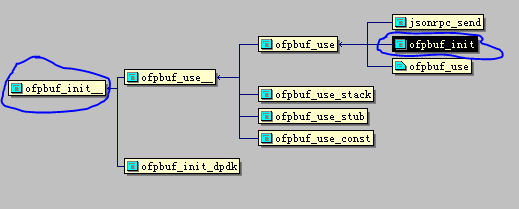
ofpbuf初始化流程,经过的函数依次是,ofpbuf_init,ofpbuf_use,ofpbuf_use__,ofpbuf_init__。(函数命名中最后是两个下划线代表是静态函数)现在我们来看一下各个函数实现。
static void
ofpbuf_init__(struct ofpbuf *b, size_t allocated, enum ofpbuf_source source)
{
b->allocated = allocated;//设置申请的内存大小 即内存块大小
b->source = source;//内存的类型,当前实例是malloc类型
b->frame = NULL;
b->l2_5_ofs = b->l3_ofs = b->l4_ofs = UINT16_MAX;
list_poison(&b->list_node);
}
static void
ofpbuf_use__(struct ofpbuf *b, void *base, size_t allocated,
enum ofpbuf_source source)
{
ofpbuf_set_base(b, base);//设置base
ofpbuf_set_data(b, base);//设置data 此时base和data保存的都是内存起始位置,只不过是data会变化,base不变
ofpbuf_set_size(b, 0);//设置已经使用的内存大小 起初为0
ofpbuf_init__(b, allocated, source);
}
/* Initializes 'b' as an empty ofpbuf that contains the 'allocated' bytes of
* memory starting at 'base'. 'base' should be the first byte of a region
* obtained from malloc(). It will be freed (with free()) if 'b' is resized or
* freed. */
void
ofpbuf_use(struct ofpbuf *b, void *base, size_t allocated)
{
ofpbuf_use__(b, base, allocated, OFPBUF_MALLOC);//内存类型为malloc类型
}
/* Initializes 'b' as an empty ofpbuf with an initial capacity of 'size'
* bytes. */
void
ofpbuf_init(struct ofpbuf *b, size_t size)
{
ofpbuf_use(b, size ? xmalloc(size) : NULL, size);
}上面是初始化操作流程,逻辑和内容十分简单。我们现在来看一下put操作,即增加内存空间。在介绍put操作之前,我们先来看四个工具函数,也是非常小的函数:
/* Returns the byte following the last byte of data in use in 'b'.
* 返回第一个可存储数据地址 针对上图返回值是 (0x832200C + 5)
*/
static inline void *ofpbuf_tail(const struct ofpbuf *b)
{
return (char *) ofpbuf_data(b) + ofpbuf_size(b); /* data_ 指向数据报文起始位置,即上面蓝色开始位置 */
}
/* Returns the byte following the last byte allocated for use (but not
* necessarily in use) by 'b'.
* <span style="font-family: Arial, Helvetica, sans-serif;">返回内存区最后一个字节地址 针对上图返回值为 (0x8322008 + 16)</span>
*/
static inline void *ofpbuf_end(const struct ofpbuf *b)
{
return (char *) ofpbuf_base(b) + b->allocated; /* base_ 指向内存区起始位置 */
}
/* Returns the number of bytes of headroom in 'b', that is, the number of bytes
* of unused space in ofpbuf 'b' before the data that is in use. (Most
* commonly, the data in a ofpbuf is at its beginning, and thus the ofpbuf's
* headroom is 0.)
* 头部剩余空间大小。 直接用data_ - base_ 就可以得到。
*/
static inline size_t ofpbuf_headroom(const struct ofpbuf *b)
{
return (char*)ofpbuf_data(b) - (char*)ofpbuf_base(b);
}
/* Returns the number of bytes that may be appended to the tail end of ofpbuf
* 'b' before the ofpbuf must be reallocated.
* 尾部剩余空间大小。
*/
static inline size_t ofpbuf_tailroom(const struct ofpbuf *b)
{
return (char*)ofpbuf_end(b) - (char*)ofpbuf_tail(b);
}下面就是扩大内存的具体函数:
/* Appends 'size' bytes of data to the tail end of 'b', reallocating and
* copying its data if necessary. Returns a pointer to the first byte of the
* new data, which is left uninitialized.
* 扩大size大小内存空间,但是不初始化
*/
void *
ofpbuf_put_uninit(struct ofpbuf *b, size_t size)
{
void *p;
ofpbuf_prealloc_tailroom(b, size); /* 在尾部,扩大内存 */
p = ofpbuf_tail(b); /* 扩展内存后,保存第一个可用内存地址 */
ofpbuf_set_size(b, ofpbuf_size(b) + size); /* 设置已用内存空间大小 */
return p;
}
/* Appends 'size' zeroed bytes to the tail end of 'b'. Data in 'b' is
* reallocated and copied if necessary. Returns a pointer to the first byte of
* the data's location in the ofpbuf.
* 扩大size大小内存空间,初始化为0
*/
void *
ofpbuf_put_zeros(struct ofpbuf *b, size_t size)
{
void *dst = ofpbuf_put_uninit(b, size);
memset(dst, 0, size);
return dst;
}
/* Appends the 'size' bytes of data in 'p' to the tail end of 'b'. Data in 'b'
* is reallocated and copied if necessary. Returns a pointer to the first
* byte of the data's location in the ofpbuf.
* 扩大size大小内存空间,用p进行初始化
*/
void *
ofpbuf_put(struct ofpbuf *b, const void *p, size_t size)
{
void *dst = ofpbuf_put_uninit(b, size);
memcpy(dst, p, size);
return dst;
}这三个函数功能都是类似的,在原有ofpbuf结构b中增大size大小的内存空间。 函数ofpbuf_put_uninit会被其他两个函数调用。我来分析一下这个函数。
ofpbuf_prealloc_tailroom 在尾部扩展内存,这个函数逻辑也是很简单
/* Returns the number of bytes that may be appended to the tail end of ofpbuf
* 'b' before the ofpbuf must be reallocated.
* 返回可用内存空间,即上图中白色空间大小
*/
static inline size_t ofpbuf_tailroom(const struct ofpbuf *b)
{
return (char*)ofpbuf_end(b) - (char*)ofpbuf_tail(b);
}
/* Reallocates 'b' so that it has exactly 'new_headroom' and 'new_tailroom'
* bytes of headroom and tailroom, respectively.
* 内存扩充函数 我们只关注malloc的内存 即红色部分
*/
static void
ofpbuf_resize__(struct ofpbuf *b, size_t new_headroom, size_t new_tailroom)
{
void *new_base, *new_data;
size_t new_allocated;
new_allocated = new_headroom + ofpbuf_size(b) + new_tailroom;
switch (b->source) {
case OFPBUF_DPDK:
OVS_NOT_REACHED();
case OFPBUF_MALLOC:
if (new_headroom == ofpbuf_headroom(b)) {//调用realloc申请内存
new_base = xrealloc(ofpbuf_base(b), new_allocated);
} else {
new_base = xmalloc(new_allocated);//调用malloc申请内存并且修改ofpbuf中相关数据
ofpbuf_copy__(b, new_base, new_headroom, new_tailroom); /* 将数据复制到新的内存空间中 需要注意头部剩余空间和使用空间。*/
free(ofpbuf_base(b));
}
break;</span>
case OFPBUF_STACK:
OVS_NOT_REACHED();
case OFPBUF_STUB:
b->source = OFPBUF_MALLOC;
new_base = xmalloc(new_allocated);
ofpbuf_copy__(b, new_base, new_headroom, new_tailroom);
break;
default:
OVS_NOT_REACHED();
}
// 重新设置allocated和base_ 指针
b->allocated = new_allocated;
ofpbuf_set_base(b, new_base);
// 重新设置data_ 指针
new_data = (char *) new_base + new_headroom;
if (ofpbuf_data(b) != new_data) {
if (b->frame) {
uintptr_t data_delta = (char *) new_data - (char *) ofpbuf_data(b);
b->frame = (char *) b->frame + data_delta;
}
ofpbuf_set_data(b, new_data);
}
}
/* Ensures that 'b' has room for at least 'size' bytes at its tail end,
* reallocating and copying its data if necessary. Its headroom, if any, is
* preserved.
* 尾部扩充内存 首先需要判断剩余内存是否满足需求,如果size大于剩余可用空间则需要重新申请内存
* 为了避免内存碎片和快速申请,每次至少申请64字节
*/
void
ofpbuf_prealloc_tailroom(struct ofpbuf *b, size_t size)
{
if (size > ofpbuf_tailroom(b)) {
ofpbuf_resize__(b, ofpbuf_headroom(b), MAX(size, 64));
}
}与pull对应函数是push,此类函数主要是在头部扩充内存,这里我们不在进行讨论。函数ofpbuf_pull主要增大灰色空间大小,即将蓝色区域向后移动size大小。
/* Removes 'size' bytes from the head end of 'b', which must contain at least
* 'size' bytes of data. Returns the first byte of data removed. */
static inline void *ofpbuf_pull(struct ofpbuf *b, size_t size)
{
void *data = ofpbuf_data(b);
ovs_assert(ofpbuf_size(b) >= size);
ofpbuf_set_data(b, (char*)ofpbuf_data(b) + size);
ofpbuf_set_size(b, ofpbuf_size(b) - size);
return data;
}最后我们来看一下释放函数,这个函数也是非常简单的。
/* Frees memory that 'b' points to. */
void
ofpbuf_uninit(struct ofpbuf *b)
{
if (b) {
if (b->source == OFPBUF_MALLOC) {
free(ofpbuf_base(b));
}
ovs_assert(b->source != OFPBUF_DPDK);
}
}上面就是本博客主要介绍的内存,ofpbuf相对简单,下面我们会分析Open vSwitch会话相关的数据结构struct connmgr,struct ofconn,struct ofproto等,这部分数据结构属于Open vSwitch管理层。对于学习Open vSwitch是非常重要。
原文链接:https://cloud.tencent.com/developer/article/1082501
(免费订阅,永久学习)学习地址: Dpdk/网络协议栈/vpp/OvS/DDos/NFV/虚拟化/高性能专家-学习视频教程-腾讯课堂
更多DPDK相关学习资料有需要的可以自行报名学习,免费订阅,永久学习,或点击这里加qun免费
领取,关注我持续更新哦! !
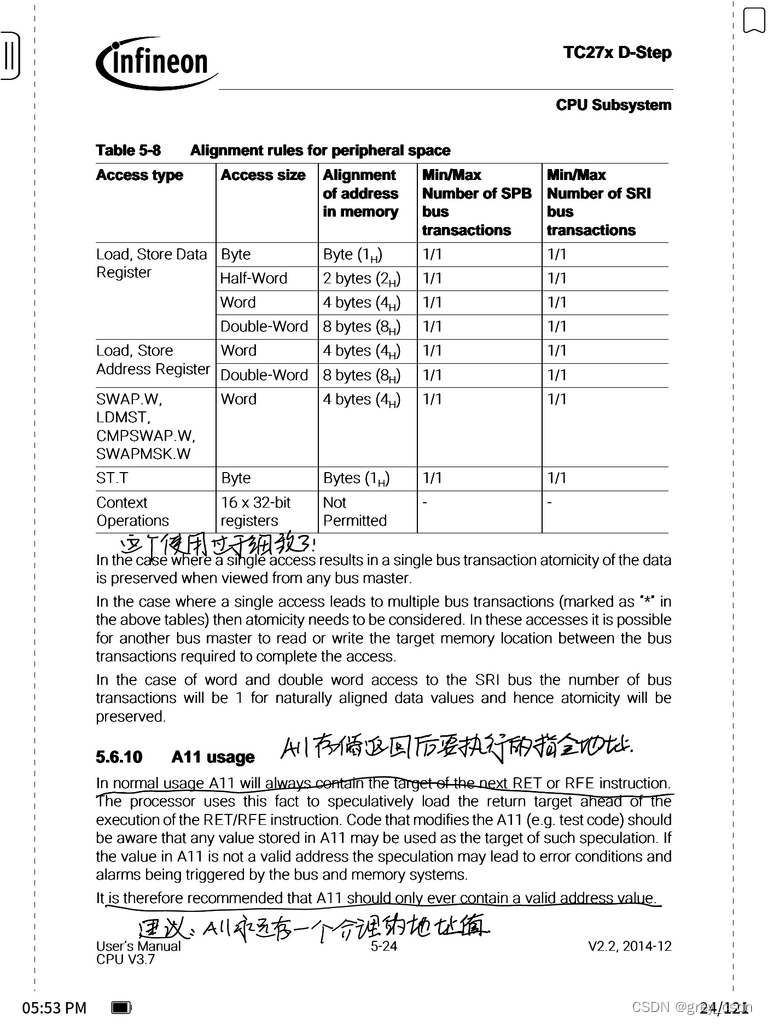
![[附源码]Python计算机毕业设计SSM辽宁科技大学二手车交易平台(程序+LW)](https://img-blog.csdnimg.cn/05f51247fafc41f7b459d329a0613e80.png)




